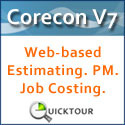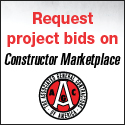
|
www.agc.org Contact Us Archives/Subscribe Advertise IT Forum IT Forum Steering Committee |
The Mobile Technology BuzzBy Lee Church
Managing Director
Systems nHand
The phrase ‘mobile technology’ breeds all sorts of questions for the construction industry: What exactly does it mean? What’s the cost? What benefits can it generate? And, how does a company get started?
This last query is the easiest to answer: Start by developing a plan. A strategic plan should lay out an organization’s issues and its current and potential use of mobile technology. Like any good strategic plan, it should evolve as time passes and the organization learns more about the technology and how to use it. The industry is abuzz over mobile technology for two main reasons: 1) the new smartphones and tablets have the potential to dramatically alter the interaction between a work site and the home office, and 2) the technology industry is excited about the financial opportunities that this new technology offers. Users should be excited too, because the cost of deploying connected, powerful devices has decreased by over 90 percent in the last five years.
TYPES OF IMPLEMENTATION
What constitutes a mobile technology implementation? First off, the scope of the project must be defined:
Simple – Make available certain key pieces of information or forms that the field staff need on a regular basis. This is primarily a "push" of files to field devices.
Moderately complicated – Attack a key point of pain in field staff operations (punch list, payroll time entry, daily job reporting, accident reports, etc.). This typically means gathering data in the field and pushing it back to the home office.
Complex – Put the entire workflow for the field staff onto a mobile device, with real-time or on-demand data connection to the back-office system. In this case data typically flows in both directions.
There is no reason to start a mobile technology implementation by defining a complex project as the first step. Start with a simple project that pushes out forms like MSDS safety sheets, employee policy manuals, and other documentation that can be presented in PDF format. This can be done on a small smartphone at very low cost. It represents a method for an organization to begin to understand the usage and changes that mobile technology will push into new areas. This implementation requires no significant investment in software or support but can be an important first step for any organization.
MOBILE IMPLEMENTATION COMPONENTS
Five components are key for a mobile implementation:
COST
Cost is always a key issue when evaluating new investments, whether it’s a new road grader or tablet computer. But as with most investments, mobile technology payback depends upon the implementation in a specific environment. Starting with a simple implementation and a BYOD policy can lower the initial costs substantially, but it may be very difficult to prove the actual financial benefits. More complex applications that target specific problems may cost substantially more, but typically provide much higher payback and more easily quantifiable benefits.
MAKING IT WORK
There is a company in the Southeast U.S. involved in heavy road construction that makes mobile work every single workday. Prior to implementing its mobile daily reporting system, it had no mobile strategy or implementation. Its initial mobile application replaced a paper form that the field superintendent filled out each day for each job that his crew worked on. This is a very typical way for companies to do an initial implementation, by replicating a paper-based reporting system onto an electronic device. The total initial investment by the company was less than $100,000, but the CFO of the organization has quantified payback on that investment in less than 12 months.
Subsequently, the company has spent additional monies each and every year to upgrade and expand the applications on the devices, as well as the devices themselves. Field superintendents now use a 7-inch tablet and carry a very small portable printer so they can create and print the formatted reports required in their regulatory environment.
Over the last five years the company has expanded geographically and now covers over six states in the Southeast. The mobile application has supported this expansion because it does not matter if a crew is one mile or a thousand away from the office; the information is sent as needed. And within 15 minutes after the report is submitted from the field, copies are distributed to all relevant stakeholders (regulatory agencies, customers, company management, payroll and billing) via data import, or reports via fax, e-mail or hard-copy print.
THE THREE "V"S
Mobile applications impact three primary characteristics: volume, velocity and validity.
BENEFITS
Very few construction projects are completed at the office. Having work crews able to access project and other information and quickly and easily collect and forward field information to the home office is an important benefit. Studies show that the construction industry has not seen significant increases in employee productivity over the last 20 years. And, compared to other major industries, construction has historically underinvested in technology. People are the most valuable asset, and mobile technology is one place where there are significant opportunities to enhance the process for customers and employees and affect the bottom line.
Empower employees with technology and the business processes will be enhanced and more powerful:
Getting started means developing the technology plan that recognizes where the organization has bottlenecks or failures that could be eased or eliminated by implementing a mobile application of some form. A mobile system is not a cost, but an investment made to refine and enhance the company’s business processes.
Lee Church is managing director of Systems nHand, based in Austin, Texas, specializing in development of mobile technology applications. Staff at the firm have over 150 years of combined IT experience, and over 30 years of specific development of smartphone, PDA, and tablet device applications. He can be reached at lee.church@systemsnhand.com.
|

2300 Wilson Boulevard, Suite 300 · Arlington, VA 22201 · 703-548-3118 (phone) · 703-548-3119 (fax) · www.agc.org
About AGC | Advocacy | Industry Topics | Programs and Events | Career Development | News & Media
© Copyright 2025 The Associated General Contractors of America. All rights reserved.


